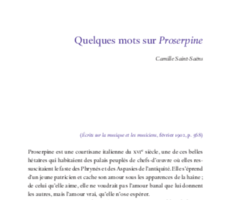Proserpine
Drame lyrique in four acts premiered at the Paris Opéra-Comique on 14 March 1887
While we might have expected the supposedly “classical” Saint-Saëns’s imagination to be fired by his interest in the fate of the ancient Proserpine, we surprisingly discover that his heroine is nothing less than a Renaissance courtesan cultivating illicit love. Saint-Saëns skilfully summed up the real dramatic stakes of his drame lyrique, far removed from the repertoire of the Opéra-Comique, where it was premiered: “Angiola is innocence, candour, pure and virginal love; Proserpine is a damned woman, for whom true love is a forbidden fruit; as soon as she touches it, it becomes a torture. [...] What happens is both unexpected and terrible: the chaste love of the saint seems little compared to the infernal passions of the courtesan. A frightening problem, indeed! Satan, the eternally cursed rebel, crushes the faithful angels with his superiority! [...] It’s the bloodthirsty beast that is admirable, the gentle being is only pretty and sympathetic.” Visibly transported by this delight in horror, Saint-Saëns indulges in an unprecedented orchestral modernism, piling up dissonances under the cries of fury or despair of his characters. And he concluded: “Of all my theatrical works, Proserpine is the most advanced in the Wagnerian system.”
Scientific publications
Publication
Camille Saint-Saëns. Proserpine
Articles


